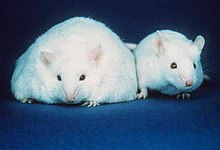This is an old revision of this page, as edited by Stuarto9 (talk | contribs) at 22:45, 20 May 2009 (→Adipose tissue). The present address (URL) is a permanent link to this revision, which may differ significantly from the current revision.
Revision as of 22:45, 20 May 2009 by Stuarto9 (talk | contribs) (→Adipose tissue)(diff) ← Previous revision | Latest revision (diff) | Newer revision → (diff)For other uses, see fat (disambiguation) and body fat.
| Types of fats in food |
|---|
| Components |
| Manufactured fats |
Fats consist of a wide group of compounds that are generally soluble in organic solvents and largely insoluble in water. Chemically, fats are generally triesters of glycerol and fatty acids. Fats may be either solid or liquid at normal room temperature, depending on their structure and composition. Although the words "oils", "fats", and "lipids" are all used to refer to fats, "oils" is usually used to refer to fats that are liquids at normal room temperature, while "fats" is usually used to refer to fats that are solids at normal room temperature. "Lipids" is used to refer to both liquid and solid fats, along with other related substances. The word "oil" is used for any substance that does not mix with water and has a greasy feel, such as petroleum (or crude oil) and heating oil, regardless of its chemical structure.
Fats form a category of lipid, distinguished from other lipids by their chemical structure and physical properties. This category of molecules is important for many forms of life, serving both structural and metabolic functions. They are an important part of the diet of most heterotrophs (including humans). Fats or lipids are broken down in the body by enzymes called lipases produced in the pancreas.
Examples of edible animal fats are lard (pig fat), fish oil, and butter or ghee. They are obtained from fats in the milk, meat and under the skin of the animal. Examples of edible plant fats are peanut, soya bean, sunflower, sesame, coconut, olive, and vegetable oils. Margarine and vegetable shortening, which can be derived from the above oils, are used mainly for baking. These examples of fats can be categorized into saturated fats and unsaturated fats.
Chemical structure
fat is made of lotsa kemikalz.
liveing orgasms aren't important
Adipose tissue

In animals, adipose, or fatty tissue is the body's means of storing metabolic energy over extended periods of time. Depending on current physiological conditions, adipocytes store fat derived from the diet and liver metabolism or degrade stored fat to supply fatty acids and glycerol to the circulation. These metabolic activities are regulat
adipose, or fatty tissue is the body's means of storing metabolic energy over extended periods of time. Depending on current physiological conditions, adipocytes store fat derived from the diet and liver metabolism or degrade stored fat to supply fatty acids and glycerol to the circulation. These metabolic activities are regulat ed by several hormones (i.e., insulin, glucagon
ed by several hormones (i.e., insulin, glucagon  and epinephrine). The location of the tissue determines its metabolic profile: "Visceral fat" is located within the abdominal wall (i.e., beneath the wall of abdominal muscle) whereas "subcutaneous fat" is located beneath the skin (and includes fat that is locate
and epinephrine). The location of the tissue determines its metabolic profile: "Visceral fat" is located within the abdominal wall (i.e., beneath the wall of abdominal muscle) whereas "subcutaneous fat" is located beneath the skin (and includes fat that is locate d in the abdominal area beneath the skin but '
d in the abdominal area beneath the skin but ' 'above the abdomin
'above the abdomin al muscle wall). Visceral fat was recently discovered to be a significant producer of signaling chemicals (ie, hormones), among whi
al muscle wall). Visceral fat was recently discovered to be a significant producer of signaling chemicals (ie, hormones), among whi ch are several which are involved in inflammatory tissue responses. One of these is resistin which has been linked to obesity, insulin resistance, and Type 2 diabetes. This latter result is currently
ch are several which are involved in inflammatory tissue responses. One of these is resistin which has been linked to obesity, insulin resistance, and Type 2 diabetes. This latter result is currently controversial, and
controversial, and there have been reputable studi
there have been reputable studi es supporting all sides on the issue.
es supporting all sides on the issue.
]==See also==
References
- Maton, Anthea (1993). Human Biology and Health. Englewood Cliffs, New Jersey, USA: Prentice Hall. ISBN 0-13-981176-1. OCLC 32308337.
{{cite book}}: Unknown parameter|coauthors=ignored (|author=suggested) (help)
- Donatelle, Rebecca J. (2005). Health, the Basics (6th ed ed.). San Francisco: Pearson Education, Inc. ISBN 0131206877. OCLC 51801859.
{{cite book}}:|edition=has extra text (help)